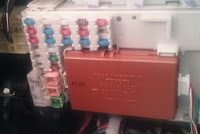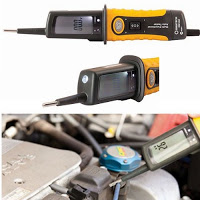Modern cars have a large amount of electrical equipment which can go wrong so it's always a good idea to perform some checks.
Chasing down electrical gremlins in a motor vehicle can bring frustration.
Different devices to use
Different devices can be used to check your car electrical from simple dwell meters and tachometers to multi-function meters with digital readouts.
To perform simple checks it’s also possible to use a simple test lamp connected between the circuit live wires and earth, but this method only indicates if there is an electrical supply to the particular point you are checking.
A more accurate way of checking circuits is to use a multi-tester meter which will indicate the level of voltage reaching the component and also check the resistance of the circuit or component.
The different components you can check :
- Battery
- Alternator
- Starter
- Wiring
- Fuses
- Ignition coil
- High tension leads
- Relays
- Sensors
- Fans
- Electrical harness
Further troubleshooting can be performed :
- Electrical leakage
- Ground connection
The better the equipment you use the easier and faster you will be able to fix your car electrical.
To solve Automotive Electrical Problems:
First, Starting at the battery. Check if it’s general condition. Make sure the terminals tight with no corrosion. Check the voltage should be above 12.5 Volts.
If you have a load tester you can test with the load which give you an indication of the state of the battery.
The voltage shouldn’t fall below 9 Volts.
If you don't have a load tester you can measure the voltage drop at the battery while the starter is cranking the engine.
Next, check all the fuses. Often you can fix an electrical issue just by replacing a fuse.
By replacing a fuse you are not always fixing the root cause of the problem so if that same fuse continues to blow, you need to look further into the problem. Most times if there’s a recurring problem, the new fuse will blow almost as soon as you put it in. They might be a short cut in the system.
Sometimes you can have power and ground in a circuit and it's not enough to work the load this can happen specially if you have added new accessories to your car . A bigger ground lead might need to be install.
If you car is cranking but not starting you can quickly check if there is voltage going through your high voltage ignition leads. This can be performed with a multi function tester without disconnecting the leads.
Basically if one of the component in your car is not working you can first check that the power supply to that component is correct by connecting a multi-meter to it’s connection.
- If the voltage is correct then investigate that component
- If the voltage is not right you might need to find a wiring diagram for the affected circuit which will allow you to check the circuit and the controls.
Something interesting to know about electricity is:
Electricity is not something we can necessarily see so it’s good to know ways of measuring and using electricity and the following formula (Ohm’s law ) is often useful while troubleshooting.
The . Ohm’s law is written like this:
V=RxI
I = Current Flow or Amps
V = Voltage
R = Resistance
If you know two of the three in the equation, you can figure out the value of the missing one. If you know the volts and the resistance, you can divide the volts by the resistance and find out how many amps are flowing through the circuit.
For further tuning of the ignition an Oscilloscope can be used.
With the Oscilloscope you can visualize the voltage curve during the different phase of the ignition to detect if a component is defective in the system.
A final check to do is to make sure your electrical harness is in good condition no live wire and is properly attached to the body of the car with no loose connection.
The information provided in this post are basic operations around your car electrical.
Now If you are interested to discover more advanced techniques from our Expert on,
How to make the most out of your battery including:
-Best Practices and techniques that will save you money !!
-Make the most of your car Battery and charging system.
Click here to find out all about it - doing so is completely free and comes without any obligation.

.JPG)

